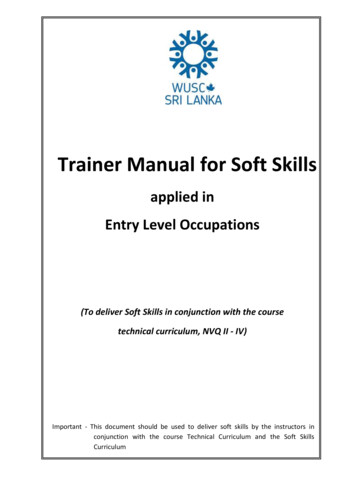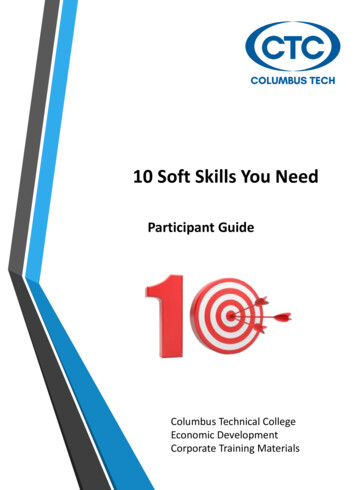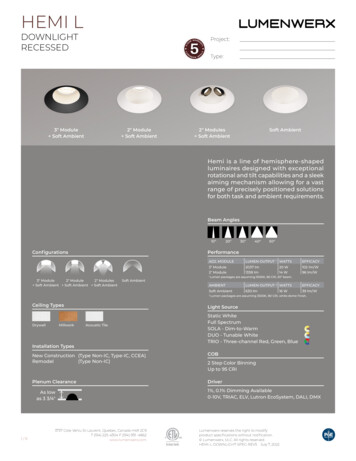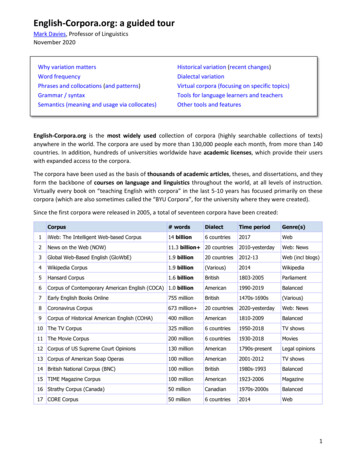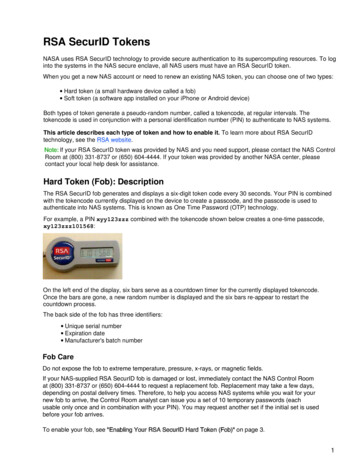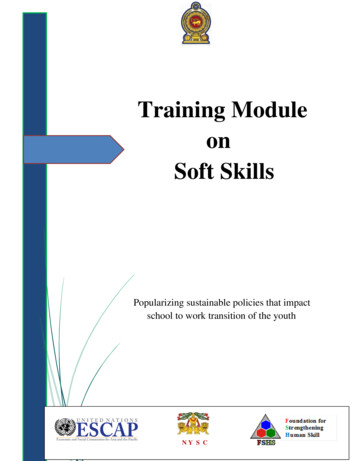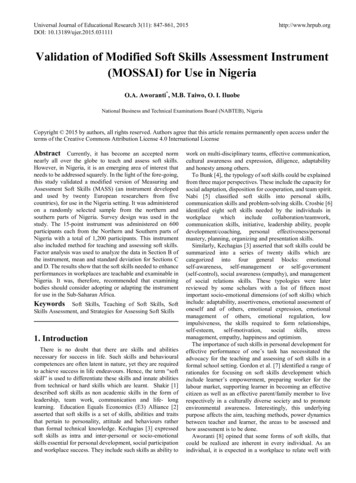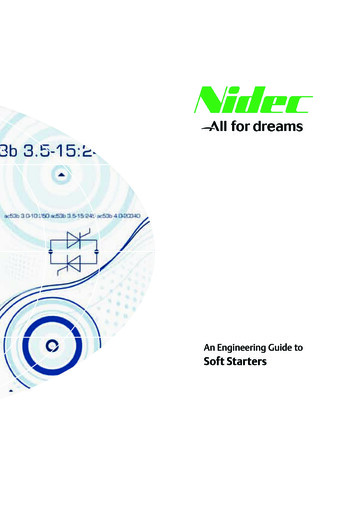
Transcription
An Engineering Guide toSoft Starters
Contents1234Introduction1.1General1.2Benefits of soft starters1.3Typical Applications1.4Different motor starting methods1.5What is the minimum start current with a soft starter?1.6Are all three phase soft starters the same?Soft Start and Soft Stop Methods2.1Soft Start Methods2.2Stop Methods2.3JogChoosing Soft Starters3.1Three step process3.2Step 1 - Starter selection3.3Step 2 - Application selection3.4Step 3 - Starter sizing3.5AC53a Utilisation Code3.6AC53b Utilisation Code3.7Typical Motor FLCsApplying Soft Starters/System Design4.1Do I need to use a main contactor?4.2What are bypass contactors?4.3What is an inside delta connection?4.4How do I replace a star/delta starter with a soft starter?4.5How do I use power factor correction with soft starters?4.6How do I ensure Type 1 circuit protection?4.7How do I ensure Type 2 circuit protection?4.8How do I select cable when installing a soft starter?4.9What is the maximum length of cable run between a soft starter andthe motor?
4.10 How do two-speed motors work and can I use a soft starter to control them?4.11 Can one soft starter control multiple motors separately for sequential starting?4.12 Can one soft starter control multiple motors for parallel starting?4.13 Can slip-ring motors be started with a soft starter?4.14 Can soft starters reverse the motor direction?4.15 What is the minimum start current with a soft starter?4.16 Can soft starters control an already rotating motor (flying load)?4.17 Brake4.18 What is soft braking and how is it used?5Digistart Soft Starter Selection5.1Three step process5.2Starter selection5.3Application selection5.4Starter sizing
1. Introduction1.1 GeneralStudies have shown that approximately 90% of the motors employed in industrial applications use noform of control other than simple electromechanical switching. This results in increased machine wearas rapid acceleration causes damaging torque transients and high peak currents. Soft starters solvethis problem through controlling the application of current during acceleration and deceleration.In applications where motor speed can be varied, significant energy savings can be realised byusing variable speed drives. However in fixed speed applications soft starters are still the mosteconomic solution.The purpose of this guide is to outline the principle benefits of using soft starters compared toother electro-mechanical start methods, and to discuss the advantages and disadvantages ofthe various soft start methods. This guide also covers some of the advanced functionality thatcan be found in today’s modern soft starters as well as the considerations when choosing andsizing soft starters.1.2 Benefits of soft startersSoft start enhances motor start performance in many ways including: Smooth acceleration without the torque transients associated with electro-mechanicalreduced voltage starters. Voltage or current is applied gradually, without the voltage and current transientsassociated with electro-mechanical reduced voltage starters. Lower start currents and/or shorter start times because constant current control giveshigher torque as motor speed increases. Easy adjustment of start performance to suit the specific motor and load. Precise control over the current limit. Consistent performance even with frequent starts. Reliable performance even if load characteristics vary between starts (eg loaded orunloaded starts).In addition to superior starting performance, soft starters also provide a range of features notavailable from other reduced voltage starters. This includes areas such as: Soft stop (which helps eliminate water hammer) Metering and monitoring Braking Operating history and event logs Motor and system protection Communication network integration
1.3 Typical ApplicationsSoft starters can offer benefits for almost all motor starting applications. Typical advantages arehighlighted in the table below.Table 1-1 Typical soft start applicationsPumps Minimised hydraulic shock in pipelines during start and stop. Reduced starting current. Minimised mechanical stress on motor shaft. Phase rotation protection prevents damage from reverse pump rotations.Conveyor Belts Controlled soft start without mechanical shocks, e.g. bottles on a belt do notfall over during starting, minimised belt stretch, reduced counterbalance stress. Controlled stop without mechanical shock (soft stop). Optimum start performance even with varying starting loads(e.g. coal conveyors start loaded or unloaded). Extended mechanical lifetime. Maintenance-free.Centrifuges Smooth application of torque prevents mechanical stress. Reduced starting times over star/delta starting.Ski Lifts Jerk-free acceleration increases skier comfort and prevents swinging T-bars etc. Reduced starting current allows starting of large motors on a weak power supply. Smooth and gradual acceleration whether the ski lift is lightly or heavily loaded. Phase rotation protection prevents operation in reverse direction.Compressors Reduced mechanical shock extends the life of the compressor, couplings and motor. Limited start current enables large compressors to be started when maximumpower capacity is limited. Phase rotation protection prevents operation in reverse direction.Fans Extended coupling life though reduced mechanical shock. Reduced start current enables large fans to be started when maximum powercapacity is limited. Phase rotation protection prevents operation in reverse direction.Mixers Gentle rotation during start-up reduces mechanical stress. Reduced starting current.
1.4 Different motor starting methods1.4.1 Star/DeltaA star/delta start configuration comprises a six terminal motor that is delta connected at thesupply voltage. The star/delta starter employs three contactors to initially start the motorin a star connection, then after a period of time, to reconnect the motor to the supply in adelta connection. While in the star connection, the voltage across each winding is reduced bya factor of the square root of 3. This results in the current and torque being one third of thefull DOL voltage current and torque whilst in star configuration. If there is insufficient torqueavailable while connected in star, the motor will only accelerate to partial speed. When thetimer operates (set normally from 5-10 seconds), the motor is disconnected from the supplyand reconnected in delta resulting in full voltage start currents and torque.Figure 1-1 Star/delta connection1231 Main contactor2 Thermal overload3 Motor (three-phase)4 Delta contactor455 Star contactorCompared with star/delta starters, soft starters are much more flexible and provide a smoothstart with no risk of transients.Star/delta starters offer limited performance because: Start torque cannot be adjusted to accommodate motor and load characteristics. There is an open transition between star and delta connection that results in damagingtorque and current transients. They cannot accommodate varying load conditions (eg. loaded or unloaded starts). They do not provide soft stop.The main advantages of star/delta starters are: They may be cheaper than a soft starter. When used to start an extremely light load, they may limit the start current to a lowerlevel than a soft starter. However, severe current and torque transients may still occur.
1.4.2 Auto-transformerAuto-transformer starters use an auto-transformer to reduce the voltage during the startperiod. The transformer has a range of output voltage taps that can be used to set the startvoltage. The motor current is reduced by the start voltage reduction, and further reducedby the transformer action resulting in a line current less than the actual motor current. Theinitial start voltage is set by tap selection, and the start time is controlled by a timer. If the startvoltage is too low, or the start time incorrectly set, the transition to full voltage will occur withthe motor at less than full speed, resulting in a high current and torque step.Figure 1-2 Auto-transformer connection121 Run contactor2 Thermal overload3 Start contactor (A)4 Start contactor (B)3545 Auto-transformerCompared with auto-transformer starters, soft starters are much more flexible and provide amuch smoother start.Auto-transformer starters offer limited performance because: They offer only limited ability to adjust start torque to accommodate motor and loadcharacteristics. There are still current and torque transients associated with steps between voltages. They are large and expensive. They are especially expensive if high start frequency is required. They cannot accommodate changing load conditions. eg. loaded or unloaded starts. They cannot provide soft stop.
1.4.3 Primary resistance startersFor primary resistance starting, resistors are connected in series with each phase, between theisolation contactor and the motor. The voltage drop across the resistors results in a reducedvoltage applied to the motor, thus reducing start current and torque.The reduced voltage starttime is controlled by a preset timer. If the time is too short, the motor will not have achievedfull speed before the resistors are bridged. Start voltage is determined by the resistors used. Ifthe resistance is too high there will be insufficient torque to accelerate the motor to full speed.Figure 1-3 Primary resistance connection21 Line contactor2 Run contactor3 Thermal overload1434 Start resistorsCompared with primary resistance starters, soft starters are more flexible and reliable.Primary resistance starters offer limited performance because: Start torque cannot be fine-tuned to match motor and load characteristics. Current and torque transients occur at each voltage step. They are large and expensive. Liquid resistance versions require frequent maintenance. Start performance changes as the resistance heats up, so multiple or restart situationare not well controlled. They cannot accommodate changing load conditions (eg loaded or unloaded starts). They cannot provide soft stop.www.controltechniques.com9
1.4.4 Variable speed drivesA variable speed drive (VSD) is a device that can control the speed of an electric motor bycontrolling the frequency and voltage of the electrical power supplied to it. When a drive startsa motor, it initially applies a low frequency and voltage to the motor thus allowing high inrushcurrents to be avoided.As drives can be used to control the speed of the motor substantial energy savings are possiblewhen the motor can be run at a reduced speed.If the application cannot be run at part speed then a soft starter will be a more energy efficientsolution compared to a drive, at least where a contactor is used to bypass the starter oncethe motor is at full speed. In such applications a soft starter will require less capital outlaycompared to a drive.1.5 What is the minimum start current with a soft starter?Soft starters can limit start current to any desired level. However, the minimum level of startcurrent for a successful start depends on the motor and load.To start successfully, the motor must produce more acceleration torque than the load requires,throughout the start.Reducing the start current also reduces the torque produced by the motor. The start currentcan only be lowered to the point where the torque output remains just greater than the loadtorque requirement.The likely start current can be estimated from experience, but more precise predictions requireanalysis of motor and load speed/torque curves.Figure 1-4 Successful soft startFull voltage current600%200%Current limit500%400%Full voltage start torque300%200%AccelerationtorqueTorque output atcurrent limit100%100%Load Torque curve10%20% 30% 40%50% 60%70%Speed (% Full speed)80%90% 100%Torque (% Motor full load torque)Current (% Motor full load current)700%
Figure 1-5 Unsuccessful soft startFull voltage start torqueFull voltage current600%200%500%Current limit400%Accelerationtorque300%Torque output atcurrent limit200%100%Stall100%Torque (% Motor full load torque)Current (% Motor full load current)700%Load Torque curve10%20% 30% 40%50% 60%70%80%90% 100%Speed (% Full speed)1.6 Are all three phase soft starters the same?No. There are different styles of soft starter which control the motor in different ways and offerdifferent features.Single phase controlThese devices reduce torque shock at start but do not reducestart current. Also known as torque controllers, these devicesmust be used in conjunction with a direct on-line starter.Two phase controlThese devices eliminate torque transients and reduce motorstart current. The uncontrolled phase has slightly higher currentthan the two controlled phases during motor starting. They aresuitable for all but severe loads.Three phase controlThese devices control all three phases, providing the optimum insoft start control. Three phase control should be used for severestarting situations.
2. Soft Start and Soft Stop Methods2.1 Soft Start MethodsSoft starters offer a variety of methods to control motor starting. Each soft start method uses adifferent primary control parameter.Table 2-1 Soft start methodsSoft Start MethodParameter ControlledPerformance Parameters InfluencedTimed Voltage RampVoltageStart current, start torque, accelerationConstant CurrentCurrentStart torque, accelerationTorque ControlTorqueStart current, accelerationAdaptive Acceleration ControlAccelerationStart current, start torqueBest results are obtained by selecting the soft start method that directly controls theparameter of most importance for the application. Typically soft starters are used to limitmotor start current or control load acceleration and/or deceleration.2.1.1 Timed Voltage Ramp (TVR) StartingTimed voltage ramp (TVR) was the earliest form of soft starting. TVR slows the application ofvoltage, which reduces the start current. This reduces start torque and slows the motor’s rateof acceleration.The main benefits of voltage control are: reduced start current and start torque elimination of mechanical and electrical transientsTVR soft starting is not suitable for high inertia loads (such as fans), which require a high levelof voltage to accelerate the load.TVR soft starting is widely used in open loop (voltage controlling) soft starters. TVR softstarting is not commonly found in closed loop soft starters, which monitor and control current.Figure 2-1 TVR soft startVoltage (% full voltage)31 Initial start voltage2 Full voltage23 Initial start time1Time
2.1.2 Current limit startingWith current limit starting, the soft starter delivers voltage to the motor until it reaches aspecified current level, then pauses the voltage ramp. When the current drops, the voltageramp continues. This keeps start current within the required limit, although the motor’s actualcurrent level varies throughout the start.This can be useful for generator set applications where the supply is limited.2.1.3 Constant currentWith constant current starting, the current is raised from zero to a specified level and keeps thecurrent stable at that level until the motor has accelerated.Constant current starting is ideal for applications where the start current must be kept below aparticular level.Figure 2-2 Constant current soft startCurrent (%motor full load current)1 Initial current3700%600%2 Current limit500%3 Full voltage current2400%300%1200%100%10%20% 30% 40%50%60%70%80%90% 100%Rotor speed (% full speed)2.1.4 Current RampCurrent ramp soft starting raises the current from a specified starting level (1) to a maximumlimit (3), over an extended period of time (2).Current ramp starting can be useful for applications where: the load can vary between starts (for example a conveyor which may start loaded orunloaded). Set the initial current to a level that will start the motor with a light load, andthe current limit to a level that will start the motor with a heavy load. the load breaks away easily, but starting time needs to be extended (for example acentrifugal pump where pipeline pressure needs to build up slowly). the electricity supply is limited (for example a generator set), and a slower applicationof load will allow greater time for the supply to respond.
Figure 2-3 Current ramp soft startCurrent (% motor full load current)1 Initial current4700%2 Start ramp time600%3 Current limit2500%4 Full voltage current3400%300%200%100%110%20% 30% 40%50%60%70%80%90% 100%Rotor speed (% full speed)2.1.5 Torque ControlTorque control is promoted as a method of providing a more linear speed ramp in soft starters.By providing a constant acceleration torque, torque control will allow the motor to speed up orslow down in a linear fashion.Torque control monitors current and power factor, and adjusts the output power of the motorto make the torque difference between the motor and load as constant as possible.Torque control is suitable for applications where: load torque is constant (linear) throughout the start load torque is constant between starts.2.1.6 Adaptive Control for StartingAdaptive Acceleration Control is a new intelligent motor control technique. In an adaptivecontrol soft start, the soft starter adjusts the current in order to start the motor within aspecified time and using a selected acceleration profile.Every application has a particular starting profile, based on characteristics of the load andthe motor. Adaptive Acceleration Control offers three different starting profiles, to suit therequirements of different applications. Selecting a profile that matches the inherent profileof the application can help smooth out acceleration across the full start time. Selecting adramatically different Adaptive Control profile can somewhat neutralise the inherent profile.The soft starter monitors the motor’s performance during each start, to improve control forfuture soft starts.NoteAdaptive Control controls the motor’s speed profile, within the programmed time limit. This may result ina higher level of current than traditional control methods.
Figure 2-4 Adaptive Control soft start1 Early ion3 Late acceleration24 Start time60%50%340%30%20%10%0%TimeHow to Select the Adaptive Acceleration Control Start ProfileThe best profile will depend on the exact details of each application. If you have particular operationalrequirements, discuss details of your application with your local supplier.Some loads, such as submersible pumps, should not be run at slow speeds. An early accelerationprofile will raise the speed quickly, then control acceleration through the rest of the start.Table 2-2 Adaptive Control profiles for common applicationsApplicationParameterSuggested valuePump CentrifugalAdaptive Start ProfileAdaptive Stop ProfileEarly AccelerationLate DecelerationPump SubmersibleAdaptive Start ProfileAdaptive Stop ProfileEarly AccelerationLate DecelerationFan DampedStart ModeCurrent LimitConstant Current350%Fan UndampedAdaptive Start ProfileConstant AccelerationCompressor ScrewStart ModeCurrent LimitConstant Current400%Reciprocating CompressorStart ModeCurrent LimitConstant Current450%ConveyorStart ModeCurrent LimitAdaptive Stop ProfileConstant Current400%Constant DecelerationCrusher RotaryStart ModeCurrent LimitConstant Current400%Crusher JawStart ModeCurrent LimitConstant Current450%
2.1.7 KickstartKickstart provides a short boost of extra torque at the beginning of a start, and can be used inconjunction with current ramp or constant current starting.Kickstart can be useful to help start loads that require high breakaway torque but thenaccelerate easily (for example flywheel loads such as presses).Figure 2-5 Current ramp soft start with kickstartCurrent (% motor full load current)700%600%500%61 Kickstart level22 Kickstart time13 Initial current4400%4 Start ramp time55 Current limit300%200%6 Full voltage current3100%10%20% 30% 40%50%60%70%80%90% 100%Rotor speed (% full speed)2.2 Stop MethodsSoft starters offer a variety of methods for the control of motor stopping.Table 2-3 Soft stop methodsStop MethodPerformance ResultCoast To StopNatural load run downTVR Soft StopExtended run down timeAdaptive ControlExtended run down time according to selected deceleration profileSTV StopExtended run down timeBrakeReduced run down timeSoft starters are often used in pumping applications to eliminate the damaging effects of fluidhammer. Adaptive Control should be the preferred stop method for these applications.2.2.1 Coast to StopCoast to stop lets the motor slow at its natural rate, with no control from the soft starter. Thetime required to stop will depend on the type of load.
2.2.2 Timed Voltage Ramp (TVR) Soft StopFigure 2-6 TVR soft stopTimed voltage ramp reduces the voltage tothe motor gradually over a defined time. Theload may continue to run after the stop rampis complete.100%Voltage (% full voltage)90%Timed voltage ramp stopping can be usefulfor applications where the stop time needsto be extended, or to avoid transients ongenerator set supplies.180%70%60%50%40%30%20%10%0%Time1 Stop time2.2.3 Adaptive Control for StoppingIn an adaptive control soft stop, the soft starter controls the current in order to stop the motorwithin a specified time and using a selected deceleration profile. Adaptive Deceleration Controlcan be useful in extending the stopping time of low inertia loads.NoteAdaptive control does not actively slow the motor down and will not stop the motor faster than a coast tostop. To shorten the stopping time of high inertia loads, use brake.Every application has a particular stopping profile, based on characteristics of the load andthe motor. Adaptive Deceleration Control offers three different stopping profiles. Choose theadaptive control profile that best matches your application requirements.Figure 2-7 Adaptive Deceleration Control soft stop4100%390%270%Speed2 Constant deceleration3 Late deceleration80%4 Stop time60%50%1 Early deceleration140%30%20%10%0%TimeThe advent of Adaptive Control has made solving the problem of fluid hammer easier as themost appropriate deceleration profile can be selected for the application.
Table 2-4 Adaptive Deceleration Control soft stop profilesAdaptive Stop ProfileApplicationLate DecelerationHigh head systems where even a small decrease in motor/pump speedresults in a rapid transition between forward flow and reverse flow.Constant DecelerationLow to medium head, high flow applications where the fluid has highmomentum.Early DecelerationOpen pump systems where fluid must drain back through the pumpwithout driving the pump in reverse.NotePump stopping: The hydraulic characteristics of pump systems vary considerably. This variation meansthe ideal deceleration profile and stop time will vary from application to application. The table providesguidelines on selecting between Adaptive Control deceleration profiles, but we recommend testing thethree profiles to identify the best profile for the application.How to Select the Adaptive Deceleration Control Stop ProfileThe best profile will depend on the exact details of each application. If you have particularoperational requirements, discuss details of your application with your local supplier.NoteAdaptive Control controls the motor’s speed profile, within the programmed time limit. This may result ina higher level of current than traditional control methods.2.3 JogJog runs the motor at reduced speed, to allow alignment of the load or to assist servicing. Themotor can be jogged in either forward or reverse direction.The maximum available torque depends on the soft starter. Check the soft starter User Guidefor details.Figure 2-8 Jog operation70%360%31 Jog ForwardAvailable jog torque50%2 Jog Reverse40%30%20%3 Normal Operation110%0%10%20%230%40%50%Time
3. Choosing Soft Starters3.1 Three step process1. Identify the features required. This will help you choose the best starter to suit your application.2. Identify your application. This will tell you the start current required.3. Calculate which starter model matches your requirement.3.2 Step 1 - Starter selectionYou need to select a starter that offers the features you require for the application. This may include: the best start method for the application input and output options to interface with external equipment serial communication control specific protections3.3 Step 2 - Application selectionDifferent applications typically require different levels of start current.The level of start current affects how many starts the soft starter can complete per hour. Somesoft starters may not offer high enough start current for extreme applications.
3.3.1 Typical Start Current RequirementsAgitator Fan - High PressureAtomiser Grinder Hydraulic Power Pack Bottle Washer 300%Table 3-1 Typical start current requirements Centrifuge Mill Chipper Mill - Ball Compressor - Reciprocal (loaded) Mill - Hammer Compressor - Reciprocal (unloaded) Mill - Roller Compressor - Screw (loaded) Mixer Compressor - Screw (unloaded)Pelletiser Conveyor - BeltConveyor - Roller Conveyor - ScrewCrusher - ConePlanerPress Pump - Bore Pump - Centrifugal Crusher - Jaw Pump - Positive Displacement Crusher - Rotary Pump - Slurry Crusher - Vertical Impact Re-pulper Debarker Rotary Table Sander Dryer Dust Collector Saw - BandsawEdger Saw - CircularFan - Axial (damped) Separator Shredder Fan - Axial (un-damped)Fan - Centrifugal (damped)Fan - Centrifugal (un-damped) Slicer Tumbler
3.4 Step 3 - Starter sizingThe soft starter must be the correct size for the motor and the application.Select a soft starterthat has a current rating at least equal to the motor’s full load current (nameplate) rating, atthe start duty.For example: application: centrifugal pump full load current: 213 A starts and stops: required to start and stop twice daily (evenly through the day) other features required: water hammer control is requiredTypical start current for a centrifugal pump is 350%. You need to select a soft starter modelwhich is rated 213A at 350% FLC. The best soft stop method to control water hammer isAdaptive ControlOther factors that may affect the sizing are: environmental conditions (altitude or ambient temperature) is the installation bypassed or non-bypassed is the connection in-line or inside delta
3.5 AC53a Utilisation CodeThe AC53a Utilisation Code defines the current rating and standard operating conditions for anon-bypassed soft starter.The soft starter’s current rating determines the maximum motor size it can be used with. Thesoft starter’s rating depends on the number of starts per hour, the length and current levelof the start, and the percentage of the operating cycle that the soft starter will be running(passing current).The soft starter’s current rating is only valid when used within the conditions specified in the utilisationcode. The soft starter may have a higher or lower current rating in different operating conditions.Figure 3-1 AC53a utilisation code351A : AC-53a3.515: 506Starts per hourOn-load duty cycle (%)Start time (s)Start current (multiple of motor full load current)Starter current rating (A)Starter current rating:The full load current rating of the soft starter given the parametersdetailed in the remaining sections of the utilisation code.Start current:The maximum available start current.Start time:The maximum allowable start time.On-load duty cycle:The maximum percentage of each operating cycle that the soft startercan operate.Starts per hour:The maximum allowable number of starts per hour.4526Current350%1100%73Operating cycle TimeStart time Running timeStart time Running time Off time1Start current2Start time3On-load time4Starts per hour5Running time6Off time7Motor FLC
3.6 AC53b Utilisation CodeThe AC53b utilisation code defines the current rating and standard operating conditions for abypassed soft starter (internally bypassed, or installed with an external bypass contactor).The soft starter’s current rating determines the maximum motor size it can be used with. Thesoft starter’s rating depends on the number of starts per hour, the length and current level of thestart, and the amount of time the soft starter will be off (not passing current) between starts.The soft starter’s current rating is only valid when used within the conditions specified inthe utilisation code. The soft starter may have a higher or lower current rating in differentoperating conditions.Figure 3-2 AC53b utilisation code80A : AC-53b3.515: 345Off time (s)Start time (s)Start current (multiple of motor full load current)Starter current rating (A)Starter current rating:The full load current rating of the soft starter given the parametersdetailed in the remaining sections of the utilisation code.Start current:The maximum available start current.Start time:The maximum allowable start time.Off time:The minimum allowable time between the end of one start and thebeginning of the next start.23Start current2Start time3Off time. It includesthe time during whichthe starter is runningwith bypassed SCRs(not passing current).4Motor FLCCurrent350%11350%4Time
3.7 Typical Motor FLCsIf you don’t have accurate information on your motor’s start current characteristics, thetable below can help you estimate the likely full load current for a particular motor size. Thisinformation can help when choosing a soft starter, but will not provide an optimised solutionbecause the characteristics of different motors can vary considerably.Table 3-2 Typical motor FLCsMotor PowerCurrent rating at different voltageskWHP220-230 V380-400 V440 V500 V660-690 1401250127513402
2 Soft Start and Soft Stop Methods 2.1 Soft Start Methods 2.2 Stop Methods 2.3 Jog 3 Choosing Soft Starters 3.1 Three step process 3.2 Step 1 - Starter selection 3.3 Step 2 - Application selection 3.4 Step 3 - Starter sizing 3.5 AC53a Utilisation Code 3.6 AC53b Utilisation Code 3.7 Typical Motor FLCs 4 Applying Soft Starters/System Design
